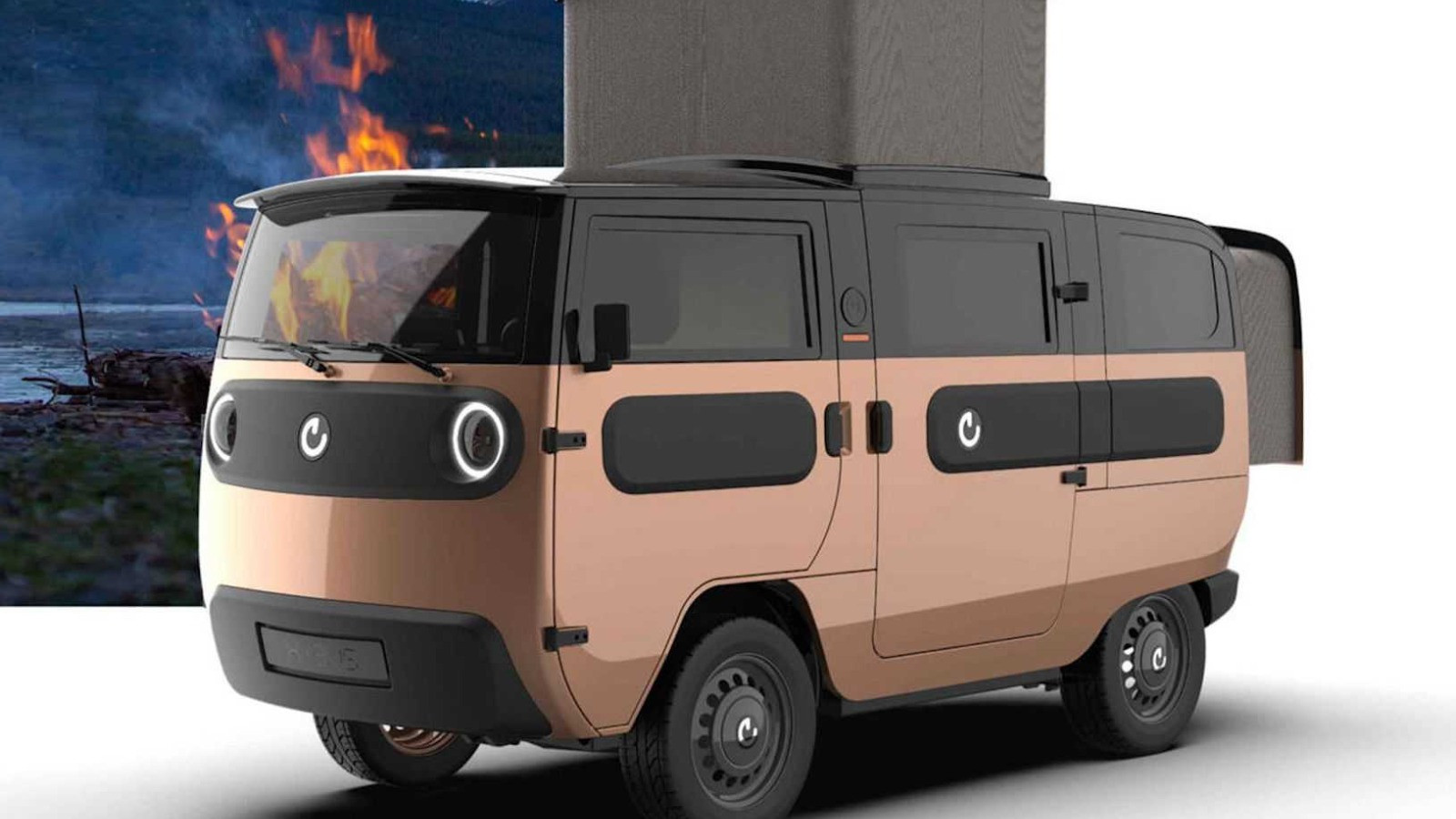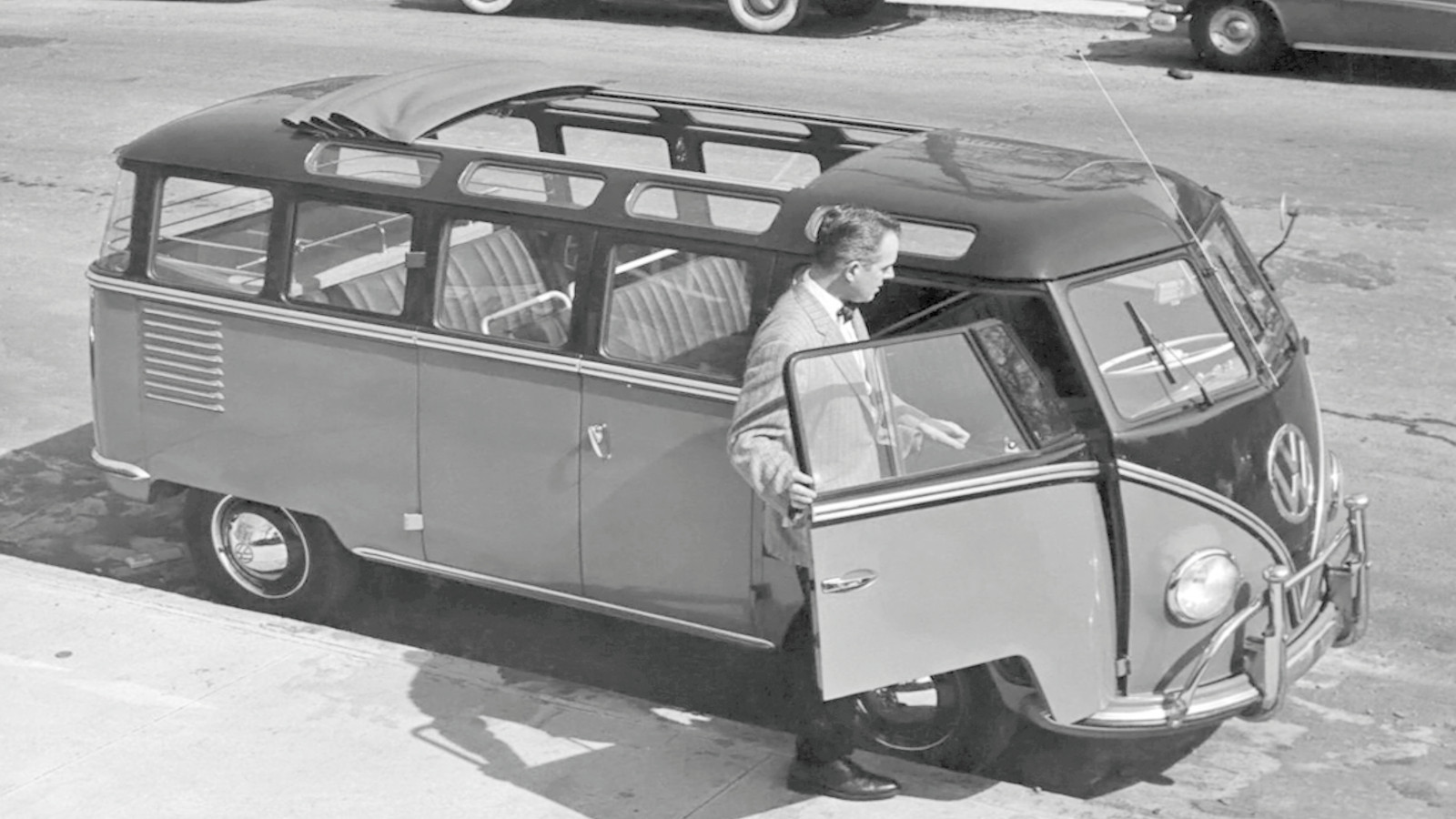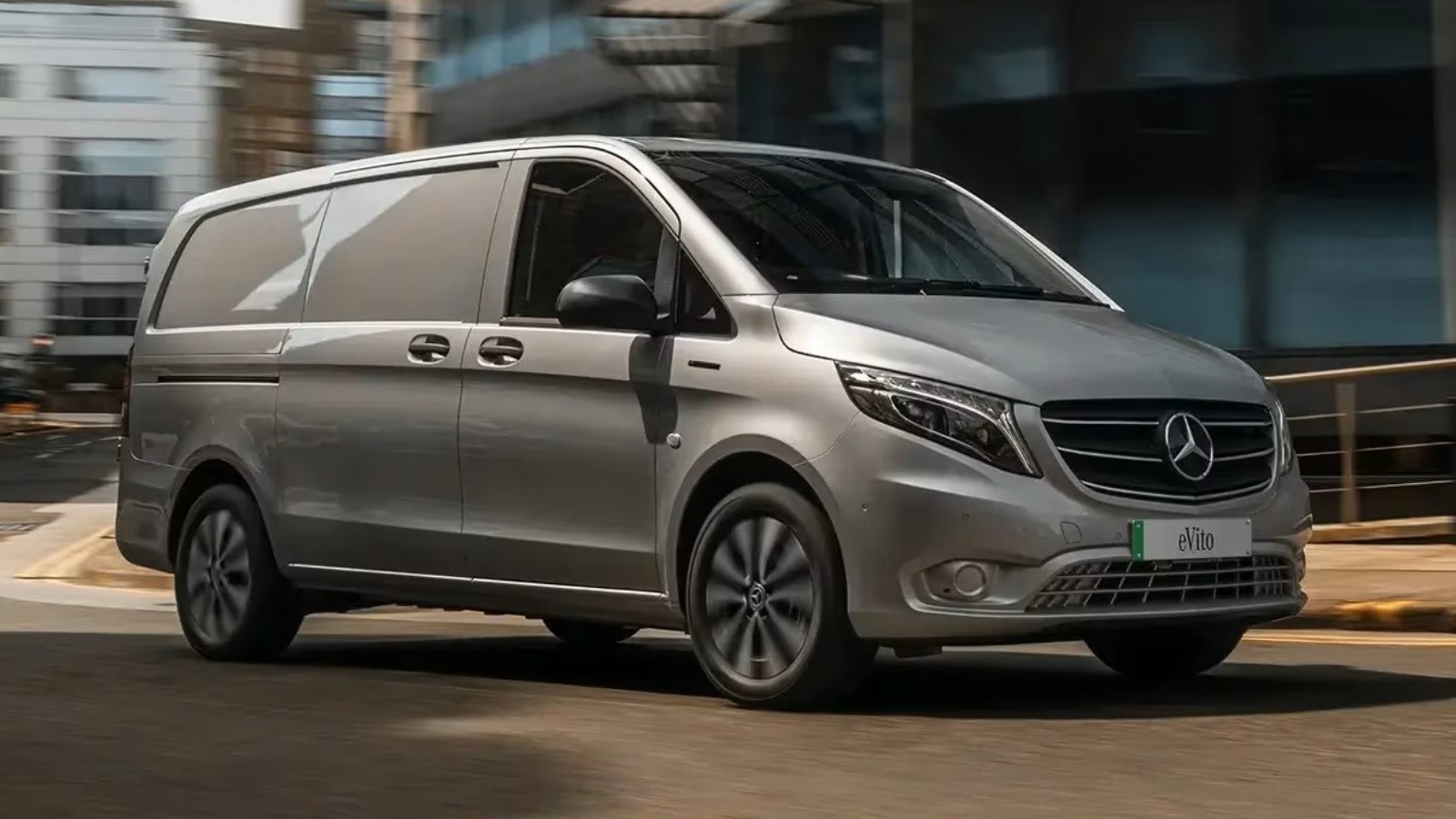-
 ©
© -
 © Volkswagen
© Volkswagen -
 © Haymarket Media
© Haymarket Media -
 © Haymarket Media
© Haymarket Media -
 © Wiki Commons
© Wiki Commons -
 © Volkswagen
© Volkswagen -
 © Volkswagen
© Volkswagen -
 © Haymarket Media
© Haymarket Media -
 © MunBill
© MunBill -
 © Haymarket Media
© Haymarket Media -
 © Wiki Commons
© Wiki Commons -
 © Haymarket Media
© Haymarket Media -
 © Ford
© Ford -
 © Crown
© Crown -
 © Volkswagen
© Volkswagen -
 © Haymarket Media
© Haymarket Media -
 © Wiki Commons
© Wiki Commons -
 © Canoo
© Canoo -
 © Volkswagen
© Volkswagen -
 © Mercedes
© Mercedes -
 © Wiki Commons
© Wiki Commons
-
In some cases it’s obvious that manufacturers have taken inspiration from classic vehicles when designing their electric vans.
Here are some examples that caught our attention.
-
Volkswagen ID Buzz
This one may be quite clear but Volkswagen’s ID Buzz is heavily inspired by the VW Microbus of the 1960s and 1970s. Nearly everything including its bulbous shape, funky paint job options, large VW badge, front bonnet styling and front lights helps showcase this, but to keep with the times, VW has given it a modern interior with a touch screen alongside various other creature comforts and a punchy 201bhp motor — quite the difference from the original 24bhp air-cooled unit.
-
1950 Volkswagen Microbus
Known as the Transporter, Kombi and Microbus, it followed the Type 1 Beetle and was given the Type 2 Moniker as a result. Today, these cars are highly sought after and demand top dollar but back in the day they would’ve retailed for around £2000.
They became an emblem of counterculture in the US during the ‘60s and were often painted in bizarre psychedelic colours. There was a panel van, microbus and two and three-door pickup options. Engines included a 1.1-litre, a 1.2-litre, a 1.5-litre and a 1.6-litre.
-
Morris JE
Set to be released in 2024 is the Morris JE which takes undeviating inspiration from the Morris J-Type of 1949. It’s designed for those who want to turn heads as they drive past and pull in a crowd, and depending on what your business requires, you can have a choice of a van or a pickup.
Two-tone paint and chrome panelling allow it to look like it’s climbed directly out of the ‘50s while LED lights, a touchscreen and a 250-mile battery help it secure its place in modernity.
-
1949 Morris J-Type
Back in the 50s, Morris targeted an array of companies and offered its J-Type as a van, a pickup, an ice cream truck, a tipper truck and a milk float. It took the UK by storm, and as a result, the British Post Office bought over 6000 J-Types from around 1956 onwards. Behind the chrome slat grille was a 1.4-litre four-cylinder, derived from a Morris Oxford MO car, with 40bhp driving the rear wheels. It was mated to a three-speed gearbox. In 1961, production ceased and over 48,600 were made.
-
Volkswagen ABT e-Transporter
When it launched back in 2020, it was the first Volkswagen electric van to go on sale in the UK and had the likes of the Mercedes-Benz e-Vito, Vauxhall Vivaro-e and Peugeot e-Dispatch in its sights. While the Transporter has been going since the ‘50s, not much has changed from the ‘90s T4 variant in terms of basic physique or general aesthetics.
It’s clear that VW has stuck with the same look for the e-Transporter but has, of course, added more tech and shinier bits in a bid to keep it up-to-date.
-
1990 Volkswagen T4
Although it’s not a fully-fledged classic, the Transporter T4 was the first in the VW van line-up to cause dramatic change to that. The air-cooled engines were a thing of the past, having been phased out with the T3, and VW then offered the Transporter with front-mounted engines ranging from 1.9-litre diesels to a hot 2.8-litre VR6 — there was even a four-wheel drive (Syncro) guise.
The T4 was phased out in 2003 after selling around 1.9 million units, making way for the T5.
-
Levc VN5
Can you see it? If you’ve been around any city in the UK, especially London, you may notice that the Levc VN5 looks like the iconic London Taxi also known as the Austin FX4. Levc does make taxis, but for those wanting something off the wall, there is also a panel van variant. Looking at the Austin FX4, it looks like Levc has gained inspiration from the rounded headlights, the bonnet step, large square grille and sloped windscreen.
-
1962 Austin FX4
They’re commonly known as a ‘hackney carriage’ or ‘black cab’ and they’ve been around since 1958. In 1982, a company called Carbodies, which built the FX4 on Austin’s behalf, took over the intellectual rights and produced for another two years.
London Taxis International then took over and built it till 1997. In total, around 75,000 FX4s were made. Early cars had a 2.1-litre diesel engine that was mated to an automatic gearbox. From 1962, a 2.2-litre petrol engine was available, and in 1971, the diesel was swapped out for a new 2.5-litre.
-
Mercedes-Benz eSprinter
Its flat sides, tall roof and steep windshield are all remnants of the 1977 Mercedes TN van. The eSprinter will manage around 92 miles on a charge with the 55kWh battery and its electric motor produces 112bhp. Over the years, the Sprinter has become prettier; the square front end found on the TN was dropped and replaced with a more aerodynamic front when introduced in 1995.
-
1977 Mercedes-Benz TN
TN stood for Transporter Neu (“new” in German). Production ran from 1977 to 1995 with over 970,000 made. Depending on your needs, Mercedes offered it in minibus, cargo box, flat cargo bed and double cab variants while three wheelbases offered gross weight ratings between 2.5 and 4.6 tonnes. Most were rear-wheel drive but there were four-wheel drive variants that used modified G-Wagen parts. Petrol and diesel engines were available with power outputs ranging between 63bhp and 103bhp.
-
Ford e-Transit
At first glance, it may be difficult to see, but we think the e-Transit shares a few design flairs with the MK1 Transit, such as the revised ‘pig snout’ front grille, various body lines, the sloped bonnet and the windowless squares found on the side.
However, the e-Transit did get its height from a great ancestor known as the Thames 400E. Rather than a diesel engine, it has a 184bhp electric motor and Ford claims it’ll manage 196 miles when fully charged.
-
1965 Ford Transit
In 1965, Ford introduced the MK1 Transit for £560 to take over from the Thames 400E; it was the longest-produced Transit ever with production stopping in 1981. The Transit remained unaltered for 12 years with Ford introducing a small facelift in 1971 - and then in 1977, it received a cosmetic overhaul.
Engine choices were a 1.7 and 2.0-litre V4 petrol to begin with, a 1.8 and 2.5-litre diesel joining soon after. Throughout its life, it had engines as small as 1.3 litres and as big as 3.3 litres. In 1986, the second-gen Transit was born.
-
Crown xBus
We noticed that the xBus looks a bit like a shrunk 1979 Volkswagen Transporter T3. Its flat face — complete with circular lights that are recessed in a plastic ‘grille’, straight sides and high suspension all mimic that of the Volkswagen. The xBus is 3.9m in length, 1.6m wide and is just as tall as a T3 at 1.9m. It’s not driving around just yet as production is set to start in mid-2024 while demo vans are due to be delivered in late 2023.
-
1979 Volkswagen Transporter
Built from 1979 to 2002, the Type 2 T3 started off in life with air-cooled 1.6 and 2.0-litre options while later variants were given water-cooled units. Four-wheel drive ‘Syncro’ guises were introduced in 1985 and came fitted with a “4+G” gearbox, the G being a low gear designed for off-roading, and a 76bhp 1.9-litre engine.
The ‘80s arrived and the US Army opted to use T3s as non-tactical means of transport and they were even given their own nomenclature — “Light Truck, Commercial”. By 1985, VW had built over 1.3 million T3s already, selling them in 180 markets.
-
Arrival Van
Looking at the Arrival van, it reminds us of the Chevrolet Step-Van which too has a bonnet-like lip, small front quarter panels that sit below polygon-like windows and a sliding door opening from front to rear. Its composite-panel body is built on an aluminium frame to be light and resistant, and the body colour is moulded-in instead of being painted.
A 163bhp electric motor drives the front wheels, giving it a top speed of 75mph, and buyers can choose from four different battery options, the highest giving 211 miles of range.
-
1964 Chevrolet Step-Van King
Step Vans started out in 1950 and were known as Dubl-Dutis. Underneath, they were essentially a Chevrolet pickup truck and featured a 3.5-litre six-cylinder engine which was later uprated to 3.9 litres in 1951. The Dubl-Duti ceased production in 1955 to make way for the Step Van, a similarly shaped van, only it was now available in three sizes. Transmissions included a column-shift three-speed and a manual four-speed while a 3.8-litre, 4.1-litre and 2.6-litre diesel were also added as options. These became known as ‘Big Brown UPS Vans’, delivering packages all over the US.
-
Canoo Delivery
Founded in 2017, American startup Canoo teased its electric van line-up known as the Canoo Lifestyle Vehicle. It's inspired by retro design but mostly focuses on styling cues from the Volkswagen Type 2 split-screen camper Samba. Its shape is like the Type 2 and the ID Buzz, only it features a futuristic front consisting of black shiny panels and a windscreen that wraps around both sides. While not yet released, Canoo will offer its Lifestyle Vehicles in van, MPV and off-road Adventure guises.
-
1951 Volkswagen Samba
Volkswagen marketed the Samba as the range-topping Type 2. While it looked like a normal Type 2 to many, it had features such as roof windows and bi-parting doors instead of sliding doors, and VW would even offer it with a fabric sunroof that would nearly span over the entire seating area. Unlike normal Type 2s, Sambas were given two-tone paint as standard, something we’re not entirely sure that Canoo will offer with its Lifestyle Vehicles.
-
Mercedes eVito
The Vito has been going since 1996, competing with the likes of Volkswagen’s Transporter, Ford’s Transit, Vauxhall’s Vivaro and Renault’s Trafic. While we’re not entirely sure what influenced the Vito’s design, its bulbous shape, long body, sloping front end and sequential sweeping windshield wipers remind us of the mid-70s Mercedes L206 and L207. The eVito looks sharp and Mercedes claims that the newer variants will return 162 miles on a single charge.
-
1970 Mercedes-Benz L206 D
Originally, the L206 D started as a Hanomag Henschel F20, but due to the company being in a spot of financial bother, Daimler-Benz acquired it in the 1970s and the F20 was renamed to the L206 D. It was marketed in Europe from 1970 to 1977 with over 165,000 sold by the end of its production. It weighed just under three tonnes and buyers could spec it with a 2.0-litre 50bhp diesel or a 2.2-litre 60bhp (available from 1972).
Daimler-Benz also presented the LE 306, based on the L 206 D, which was the first all-electric van with battery exchange technology and it could return 40 miles and reach 43mph.
BY MATT MACCONNELL
